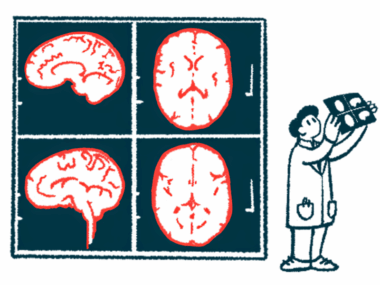Tracking brain changes in early MS can predict odds of progression
Rate of brain atrophy, changes in lesion volume may identify patients at risk
Written by |

The rate of brain atrophy, or shrinkage, and changes in brain lesion volume in the first years of treatment with Rebif (interferon beta-1a) may help predict which patients with early multiple sclerosis (MS) will receive a clinically definite diagnosis, a study suggests.
The brain radiologic measures may also predict future worsening dexterity, with the formation of new or enlarging lesions predicting a faster loss of brain volume.
The study, “Disease progression in the first 5 years of treatment in multiple sclerosis: Predictive value of early brain and lesion volume changes,” was published in the Multiple Sclerosis Journal.
MS is caused by inflammation in the central nervous system, which is composed of the brain and spinal cord. Such inflammation leads to progressive neuronal damage, which is seen as lesions on MRI scans.
Tracking the size and formation of new lesions, the shrinkage of existing lesions, or the rate of brain atrophy during the early stages of treatment has been used to predict disease progression and further inform treatment decisions in MS. However, whether the prognostic potential is improved when several of these parameters are combined remains unknown.
Researchers review MRI data from REFLEX and REFLEXION studies
To find out, a team of scientists at Amsterdam University Medical Centers, in the Netherlands, reviewed MRI data from MS patients who had participated in the REFLEX Phase 3 study (NCT00404352) and its long-term extension study REFLEXION (NCT00813709). The studies had assessed the clinical benefits of Rebif treatment in people with early MS, who had not yet received a diagnosis of clinically definite MS (CDMS).
In this study, researchers evaluated MRI scans taken in the first and second years of treatment to determine if changes in radiological measures were linked and whether they could predict conversion to definite MS or worsening disability.
Atrophy in the whole brain, or changes in global brain volume, were assessed as the percentage of brain volume change. Changes in the ventricular regions, or the fluid-filled cavities in the brain, were used to assess central atrophy.
These two brain atrophy parameters and the worsening or shrinkage of lesions were used in statistical models to determine their association with disease progression.
A total of 262 MS patients, with a mean age of 31.7 years, were included in this analysis. Of them, 105 progressed to clinically definite MS, defined as a relapse or sustained disease progression.
The researchers first designed two models taking into account MRI changes in the first year (model one) or second year (model two). They found a greater reduction in global brain volume and new lesions in the first year, as well as enlarging lesions in year two were all significantly linked to increased odds of clinically definite MS.
Clinically definite MS: Global brain atrophy in year 1, enlarging lesions in year 2
Using the significant predictors from the two models, the researchers created a third model, which found that only global brain atrophy in year one and enlarging lesions in year two remained significantly associated with CDMS.
The team also assessed whether the radiological measures were linked with clinical measures. Their data showed that no measure was significantly associated with disability levels or walking function, but disappearing lesion volume in year one and slower central atrophy in year two were both associated with a greater likelihood of experiencing worsening manual dexterity.
New lesions or enlarged lesions in the second year also were significant predictors of neurodegeneration, namely in the ventricular region.
Overall, these findings show that tracking changes in brain volume and lesions in the early days of treatment may help predict the risk of disability and disease progression.






